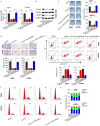Functional analysis of circSNYJ1/miR-142-5p/CCND1 regulatory axis in non-small cell lung cancer
- PMID: 39113852
- PMCID: PMC11301301
- DOI: 10.62347/PASE2970
Functional analysis of circSNYJ1/miR-142-5p/CCND1 regulatory axis in non-small cell lung cancer
Abstract
Non-small cell lung cancer (NSCLC), the most prevalent form of lung cancer, accounts for approximately 85% of all lung cancer diagnoses. Circular RNAs (circRNAs) are non-coding RNAs that play an active role in gene expression regulation, influencing cell growth, migration, and apoptosis. Here, we aimed to investigate the function of circSNYJ1 in NSCLC. In the present study, we found that circSNYJ1 expression level was increased in NSCLC tissues and cell lines. Knockdown of circSNYJ1 suppressed NSCLC cell proliferation, colony formation and migration while promoting apoptosis. Mechanistically, we demonstrated that circSNYJ1 sponged miR-142-5p, thereby regulating the expression of CCND1, a well-known cell cycle regulator. In conclusion, this study uncovered a novel circSNYJ1/miR-142-5p/CCND1 axis involved in NSCLC progression, providing potential diagnostic and prognostic biomarkers for treating NSCLC.
Keywords: CCND1; CircSNYJ1; NSCLC; biomarkers; miR-142-5p.
AJCR Copyright © 2024.
Conflict of interest statement
None.
Figures





Similar articles
-
[Overexpression of lncRNA FEZF1-AS1 promotes progression of non-small cell lung cancer via the miR-130a-5p/CCND1 axis].Nan Fang Yi Ke Da Xue Xue Bao. 2024 May 20;44(5):841-850. doi: 10.12122/j.issn.1673-4254.2024.05.05. Nan Fang Yi Ke Da Xue Xue Bao. 2024. PMID: 38862441 Free PMC article. Chinese.
-
CircRNA CDR1as knockdown inhibits progression of non-small-cell lung cancer by regulating miR-219a-5p/SOX5 axis.Thorac Cancer. 2020 Mar;11(3):537-548. doi: 10.1111/1759-7714.13274. Epub 2020 Jan 9. Thorac Cancer. 2020. PMID: 31917898 Free PMC article.
-
circRACGAP1 promotes non-small cell lung cancer proliferation by regulating miR-144-5p/CDKL1 signaling pathway.Cancer Gene Ther. 2021 Apr;28(3-4):197-211. doi: 10.1038/s41417-020-00209-0. Epub 2020 Aug 11. Cancer Gene Ther. 2021. PMID: 32778770
-
The long non-coding RNA PVT1/miR-145-5p/ITGB8 axis regulates cell proliferation, apoptosis, migration and invasion in non-small cell lung cancer cells.Neoplasma. 2020 Jul;67(4):802-812. doi: 10.4149/neo_2020_190723N657. Epub 2020 Mar 24. Neoplasma. 2020. PMID: 32202906
-
CircPKM2 aggravates the progression of non-small cell lung cancer by regulating MTDH via miR-1298-5p.Thorac Cancer. 2023 Oct;14(30):3020-3031. doi: 10.1111/1759-7714.15092. Epub 2023 Sep 7. Thorac Cancer. 2023. PMID: 37675591 Free PMC article.
References
LinkOut - more resources
Full Text Sources
Research Materials
